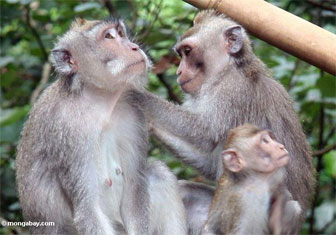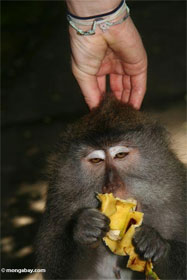Viruses can jump primate-human species barrier, researchers warn
Viruses can jump primate-human species barrier, researchers warn
University of Washington
August 23, 2006
Viruses that jump the species barrier between monkeys and humans can harm both people and animals, and we should take steps to reduce the risk of virus transmission. That’s the message running through the September issue of the American Journal of Primatology, a special issue on disease risk analysis edited by a primate expert at the University of Washington.
 Disease vector? Macaques in Indonesia could prove dangerous to your health. Photo by Rhett A. Butler
|
The special issue covers a range of topics, including an estimate of the viral transmission risk for visitors to a monkey temple in Indonesia, and a study showing how methods to limit contact between monkeys and humans can reduce the risk of transmission between the species. Other researchers describe how human viruses infecting monkeys and apes can wreak havoc on those animals’ populations.
“Viruses are already jumping the species barrier and affecting both people and animals, and there is the potential for much worse,” explained Dr. Lisa Jones-Engel, a research scientist in the Division of International Programs at the UW’s Washington National Primate Research Center and guest editor for the journal’s special issue. “It’s especially cause for concern in Asia, where people and monkeys have so much interaction, and there has been little research done on this topic.”
Scientists believe that HIV, the virus that causes AIDS, started out as simian immunodeficiency virus (or SIV), and jumped to humans decades ago when African bush meat hunters became infected by the monkeys they were hunting for food. Other viruses, like influenza, have also jumped species barriers with frightening results. In one article, researchers estimate that about six people out of every thousand who visit a monkey temple in Bali, Indonesia, will be infected with simian foamy virus (SFV) from a monkey bite. SFV is a primate retrovirus that so far has not been shown to cause disease in humans. Monkey temples are religious sites that have become gathering spots for populations of wild macaque monkeys fleeing deforested areas.
“This study is basically the first step in quantifying the risk associated with human-to-monkey viral transmission,” said lead author Dr. Gregory Engel, attending physician at Swedish/Providence Hospital in Seattle, and clinical assistant professor of family medicine at the UW. “We have a lot more work to do in determining the risk of viruses jumping the species barrier in these different settings, but the risk is obviously there.” In addition to bushmeat hunting, people are in close contact with monkeys in many settings in Asia: religious temples, open-air markets, street performances, nature preserves, zoos, and even homes, where monkeys are kept as pets. Each of these settings could provide entry points for monkey viruses like SFV to infect humans, or for human viruses like measles to jump to monkeys. Either population can be at risk from these transmissions: measles can devastate monkey populations, while some monkey viruses can also harm people.
Though SFV and a similar primate virus called SRV are not yet known to cause disease in humans, both are retroviruses, which are typically slow-acting in their host. It could be many years before physicians know the effects of those virus exposures. Other viruses carried by monkeys can cause disease and death in humans.
Visitors to monkey temples shouldn’t avoid monkeys at all costs, Engel said, but they should use caution and common sense to keep themselves and the animals safe. People should not feed the monkeys or encourage the animals to climb on them. Such precautions can help reduce the risk of exposure. In the event of a bite or scratch, proper wound care can reduce the likelihood of infection, he said.
 A bad idea |
|
“Governments and non-governmental organizations can also take steps to reduce the risk of virus transmission,” said Jones-Engel. “Better management of monkey populations, disease surveillance of human and primate populations, and improved public sanitation can all cut down on the risk of viral transmission within monkey populations, and between animals and people.”
This is a modified news release (“Viruses can jump between primates and humans, researchers warn”) from the University of Washington.